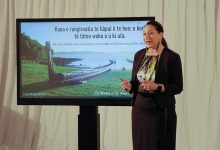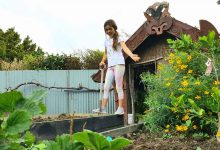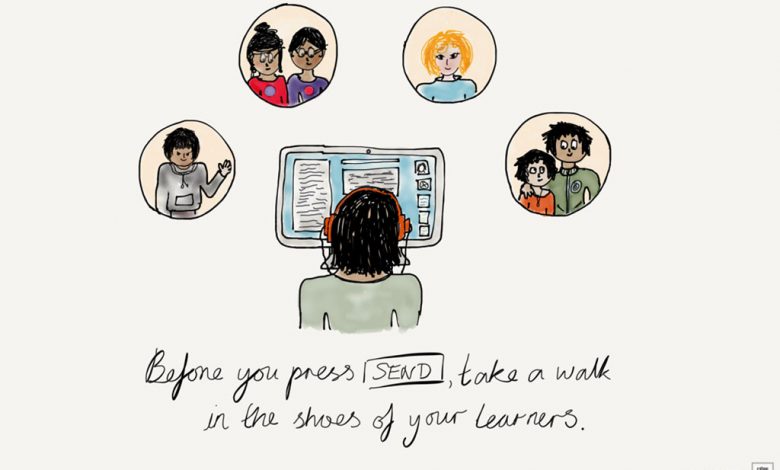
One probable constant is that blended teaching approaches, combining distance and in-person learning will be the new normal for a while.
This post:
- highlights some of the practices that can help us inclusively design distance learning options
- draws attention to approaches that can create barriers to learning and ways to minimise them.
Learning from our own experiences
Let’s begin by considering our own distance learning experiences and reflect on what we value in an online environment.
Most of us have probably had a distance learning experience in our teaching career. We’ve taken a course, attended a webinar or participated in post graduate study where we’ve had to navigate Moodle’s multiple spaces, participate in discussion forums and submit work in unfamiliar formats.
Reviewing our experience of distance learning as adults, we’d probably give quite mixed feedback.
Some of us will have relished open-ended assignments, others will have ached for structure and exemplars. Some of us will have been comfortable posting into an online forum, others will have rewritten a reply to a post ten times before daring to press send.
As we participated in online learning, our home contexts will have impacted on our study. We may have juggled care of children, work pressure, a health crisis within our whānau and/or our own mental health. Most of the time we will have managed the juggle, but sometimes we may have had to step back from the study, negotiate extensions or have a heart-to-heart with a tutor.
Now consider your ongoing use of familiar online environments, such as TradeMe, Facebook, Netflix, or an online supermarket or newspaper website:
- What do you value in an online environment you use regularly?
- What kinds of things put you off using a website?
Also reflect on your experience of being part of a teaching team during lock down:
- What kinds of communication approaches worked well for you?
- What approaches or tools have you found useful?
- What was frustrating or tiring?
Designing for humans
If you’re a designer of a distance learning experience, you know that the humans you are planning for will vary in:
- how they are engaged (what captures their attention, keeps them interested and motivated and maintains their wairua)
- how they process, make sense of and use information
- the ways they communicate, collaborate, create and express their thinking.
Planning for this level of variability is an art and also the bread and butter of teaching. As we plan for young humans in distance learning contexts, many of the approaches we use face-to face translate easily (if taking a universal design approach is already part of our practice). There are, however, some additional thoughts worth considering to ensure what we are offering will work for all our learners.
So, to support you in your review of your distance learning options so far, here are:
- two guiding thoughts
- a table of practical considerations
- a learning conversation (a video of Chrissie Butler interviewing Linda Ojala about using a UDL lens to review a lesson or activity).
Guiding thoughts
Learning support is for everyone
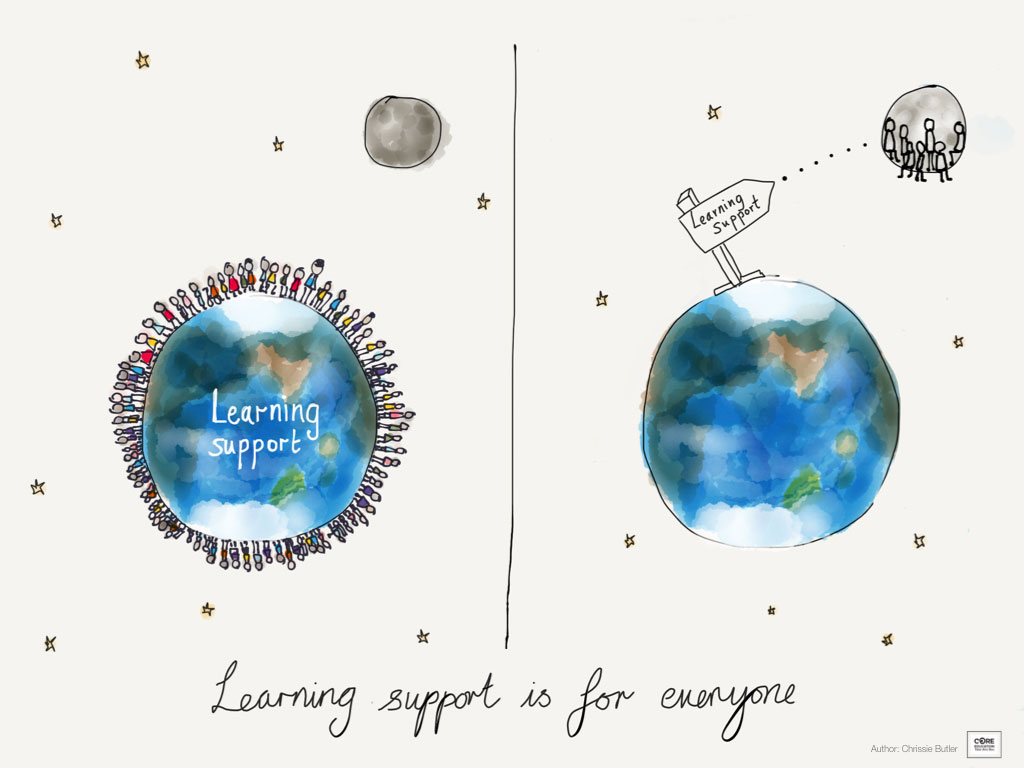 In the context of designing online learning environments, I’d recommend we think of learning support like air or water or food, it’s a necessity and a human right.
In the context of designing online learning environments, I’d recommend we think of learning support like air or water or food, it’s a necessity and a human right.
If we turn the words around and call it “support for learning”, we can see that it’s something for everyone.
As experienced kaiako, we know every young human learns differently and learning from home looks and feels different for everyone. We also know that emotion and learning are interconnected (Boekaerts, 2010) and our COVID 19 context and its consequences are having an impact on our individual and collective wellbeing and mental health. We appreciate being able to reach for the support or tools we need, when we need them, be they a pair of scissors, a how-to-video or someone to talk to.
So let’s:
- build supports, including useful tools, into the way we design our online offerings and make them available to everyone
- have ongoing conversations with our support staff, teacher aides, deans, whānau leads, guidance counsellors, SENCOs, RTLB, Learning Support Coordinators, specialist colleagues and allow their insights to influence what we design
- create spaces and opportunities where those who work closely with tamariki can maintain connection
- seek regular and ongoing feedback from tamariki and whānau regarding what helps and what gets in the way of learning.
Walk in the shoes of your learners
Before you press send, take a walk in the shoes of your learners. Imagine being on the other end of your activities or assignments. What will be your learners’ first impressions?
Will each learner think:
- Cool, I can connect to these activities, see why they are important and they are doable.
- Yay, the instructions are presented clearly in video, text and image. With no waffle!!!!!
- Great, I have options and the teacher has included everything I need to be able to get started.
Inclusive design considerations
Here are some considerations aligned to the three principles of the Universal Design for Learning (UDL) framework. You can find out more about each principle by following the link in the left hand column.
| Focus area | Things to think about | Benefits for learners |
| ENGAGEMENT Supporting engagement | Communicate in ways that engage culture, are mana enhancing and build community. |
|
| Agree with students the different ways and times they can connect with you. |
| |
| Make explicit the purpose of each activity or selection of activities. |
| |
| Offer learning activities where students can connect interests and experiences. |
| |
| Avoid “must do’s” and offer a range of can do’s. |
| |
| REPRESENTATION Support access and understanding of information and instructions | Keep the organisation of your online space laid out in a logical predictable way. |
|
| Support short video instructions with separate written instructions. |
| |
| Avoid burying instructions in your daily hello video. |
| |
| ACTION and EXPRESSION Supporting communication, action and expression | Position supports next to each activity so they can be easily accessed. |
|
| Offer multiple ways to fulfil a goal, including an option to choose their own approach. |
| |
| Make activities with increasing levels of complexity available to everyone. |
|
A learning conversation
The video below introduces how we can review a lesson or activity with a UDL lens using the UDL thinking cycle. It is an informal interview between myself and colleague Linda Ojala. It is 14 minutes long.
Downloads
- Transcript for Learning from home: Reviewing a learning activity using a UDL lens
- Reviewing a lesson with a UDL lens (reflection questions)
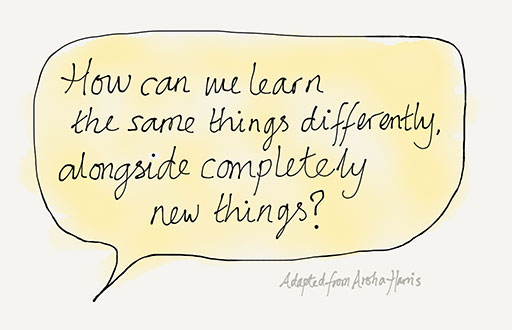 Summary
Summary
Over the last couple of months, the learning curve has been immense as we have adjusted to teaching and learning over distance.
Hopefully this learning curve will continue to expand as together with whānau and tamariki we seek feedback, discuss and reflect on:
- practices and ways of working we want to keep from our learning at home experience
- old ways of working we don’t want to repeat or revisit
- how to innovate a blended approach to teaching and learning that allows and supports every child and their whanau to access, influence and participate in learning experiences and environments that work for them.
I can imagine some of the richest discussions will be around maintaining and supporting learner agency and continuing to support close collaboration with whānau.
I also hope that we can take into the new normal some of our new learning about planning for variability, utlising digital tools and employing creative solutions, to ensure every child has access to learning in a way that works for them.
Finally, all the thoughts shared above translate directly to blended practice. They reflect a people-centred, systematic approach to design and are informed by the framework Universal Design for Learning.
Get in touch if we can help in any way or you would like to learn more about Universal Design for Learning, web accessibility and inclusive design principles and practices.
Acknowledgements
- Vonnie Jones for uttering the phrase “before you press send”.
- Linda Ojala for the interview and constant collaboration and innovation.
- The UDL and inclusive design team at CORE.
- The Aroha Harris quote can be found in the introduction to Anderson, A. (2016). The First Migration Māori Origins 3000BC – AD1450. Bridget Williams Books Ltd.
- Boekaerts, M. (2010). Chapter 4: The crucial role of motivation and emotion in classroom learning. In H. Dumont, D. Istance & F. Benavides, The Nature of Learning: Using Research to Inspire Practice. OECD Publishing. Retrieved 12 May 2020, from https://www.oecd-ilibrary.org/education/the-nature-of-learning_9789264086487-en.







